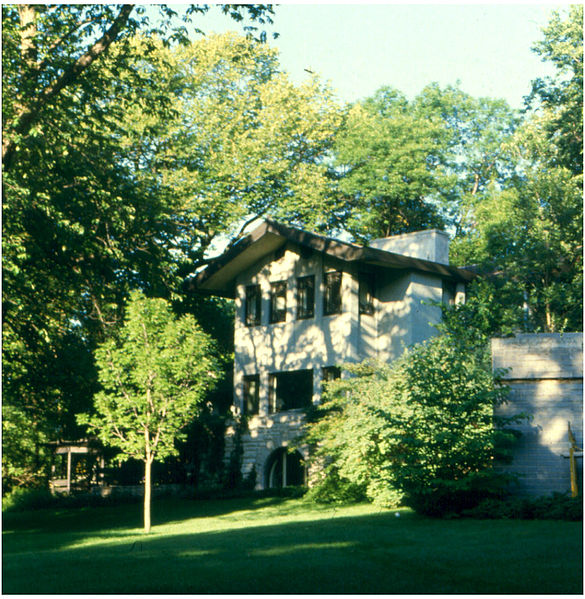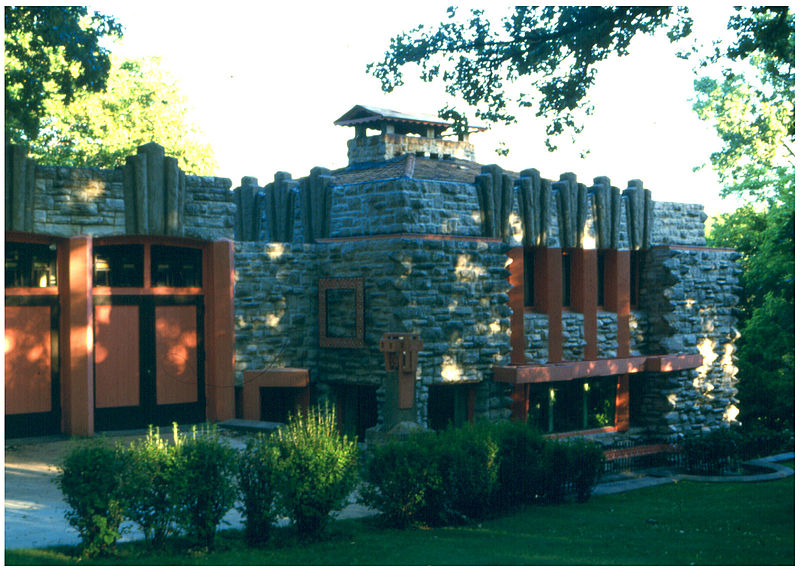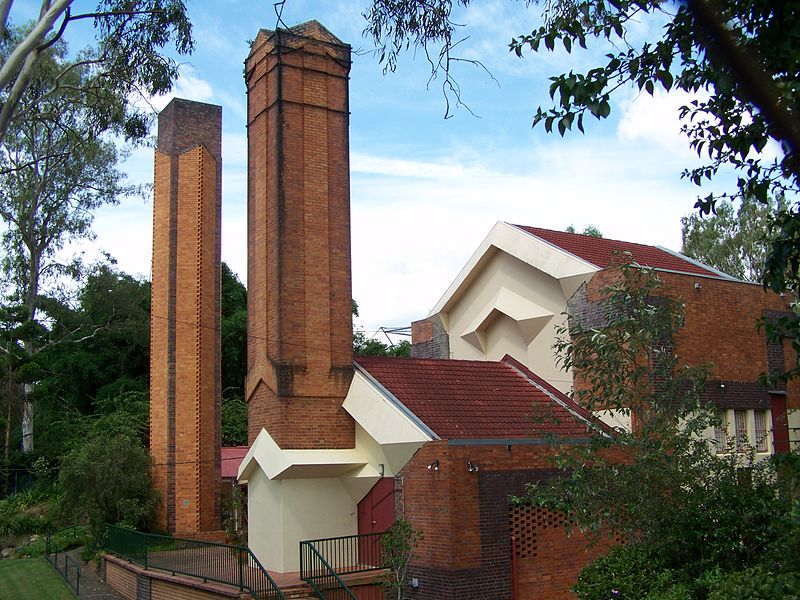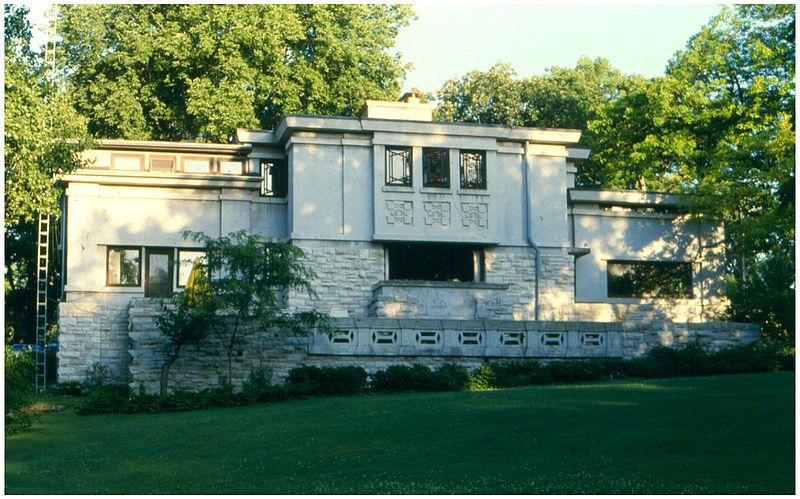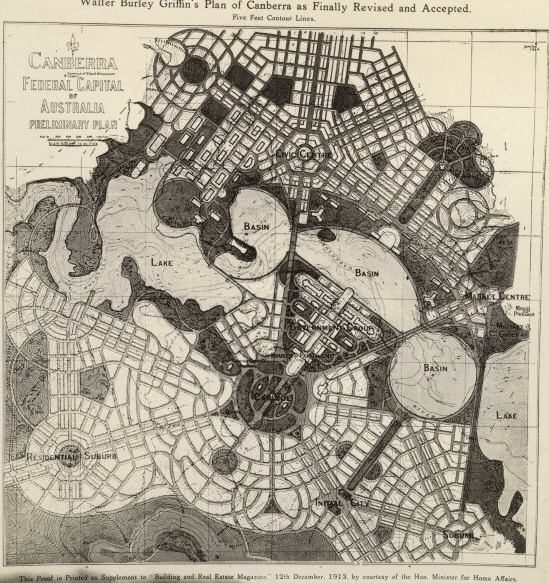<Back to Index>
- Architect Marion Mahony Griffin, 1871
- Architect Walter Burley Griffin, 1876
PAGE SPONSOR
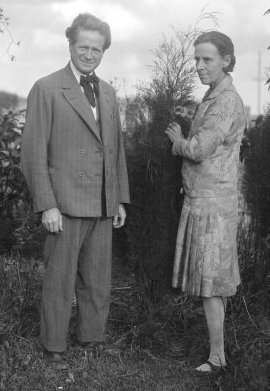
Marion Griffin (February 14, 1871 – August 10, 1961) was an American architect and artist. She was one of the first licensed female architects in the world, and is considered an original member of the Prairie School.
Marion Mahony Griffin was born in 1871 Chicago, the second child and eldest daughter of the five surviving children of Jeremiah Mahony, a journalist from Cork, Ireland, and Clara Hamilton, a schoolteacher. Her family moved to nearby Winnetka after the Great Chicago fire. Growing up there, she became fascinated by the quickly disappearing landscape as suburban homes filled the area. She was influenced by her first cousin, Dwight Perkins, and decided to further her education. She graduated from the Massachusetts Institute of Technology (M.I.T.) in 1894. She was one of the first women to receive a degree in architecture. Though highly talented, she sometimes struggled with her place in both society and the field. She was unsure of her ability to complete the thesis required for her bachelors degree, but her professor, Constant - Désiré Despradelle, pushed her forward. After graduation, Mahony worked in her cousins architecture firm. The space was shared among many architects, including Frank Lloyd Wright. In 1895 Mahony was the first employee hired by Frank Lloyd Wright and went to work designing buildings, furniture, stained glass windows and decorative panels. Her beautiful watercolor renderings of buildings and landscapes became known as a staple of Wright's style, though she was never given credit by the famous architect. Over a century later she would be known as one of the greatest delineators of the architecture field, but during her life her talent was seen as only an extension of the work done by male architects. She would be associated with Wright's studio for almost fifteen years and was an important contributor to his reputation, particularly for the influential Wasmuth Portfolio, for which Mahony created more than half of the numerous renderings. Architectural writer Reyner Banham called her the "greatest architectural delineator of her generation". Her rendering of the K.C. DeRhodes House in South Bend, Indiana, was praised by Wright upon its completion and by many critics.
Wright understated the contributions of others of the Prairie School, Mahony included. Unfortunately, the views of most architectural historians from the 1950s to 2000 follow Wright's lead. A clear understanding of Marion Mahony’s contribution to the architecture of the Oak Park Studio comes from Wright’s son, John Lloyd Wright, who says that William Drummond, Francis Barry Byrne, Walter Burley Griffin, Albert Chase McArthur, Marion Mahony, Isabel Roberts and George Willis were the draftsmen - -the five men and two women who each made valuable contributions to Prairie style architecture for which Wright became famous. During this time Mahony designed the Gerald Mahony Residence (1907) in Elkhart, Indiana, for her brother and sister - in - law.
When Wright eloped to Europe with Mamah Borthwick Cheney in 1909, he offered the Studio's work to Mahony. She declined. But after Wright had gone, Hermann V. von Holst, who had taken on Wright's commissions, hired Mahony with the stipulation that she would have control of design. In this capacity, Mahony was the architect for a number of commissions Wright had abandoned. Two examples were the first (unbuilt) design for Henry Ford's Dearborn mansion, Fair Lane, and the Amberg House in Grand Rapids, Michigan.
Mahony recommended Griffin to von Holst to develop landscaping for the area surrounding the three houses commissioned from Wright in Decatur, Illinois. Mahony and Griffin worked on the Decatur project before their marriage. After their marriage, Mahony worked in Griffin's practice. A Walter Burley Griffin / Marion Mahony designed development that is home to an outstanding collection of Prairie School dwellings, Rock Crest Rock Glen in Mason City, Iowa, is seen as their most dramatic American design development of the decade. It is the largest collection of Prairie Style homes surrounding a natural setting.
Mahony and Walter Burley Griffin married in 1911, a partnership that lasted 28 years. Griffin was a fellow architect, a fellow ex - employee of Wright, and a leading member of the Prairie School of architecture. Marion's watercolor perspectives of Walter's design for Canberra, the new Australian capital, were instrumental in securing first prize in the international competition for the plan of the city. In 1914 the couple moved to Australia to oversee the building of Canberra. Marion managed the Sydney office and was responsible for the design of their private commissions. They pioneered the Knitlock construction method, inexactly emulated by Wright in his California textile block houses of the 1920s.
Later
the Griffins practiced in India and, in less than a year, Mahony
oversaw the design of over one hundred Prairie School influenced
buildings there. Walter Griffin died in India in 1937 of peritonitis following a
cholecystectomy. Mahony then completed their work and returned to the
United States. Mahony and Griffin spread the Prairie Style to two
continents, far from its origins. She credited Louis Sullivan as
the impetus for the Prairie School philosophy. She considered Wright's
habit of taking credit for the movement explained its early death, in
the United States.
Marion Mahony Griffin died in Chicago, aged 90. Though she lived 24 years after her husband's death, she did little in her elderly years to further advance her own architectural career. "The one time she addressed the Illinois Society of Architects, she made no mention of her work, instead lectured the crowd on anthroposophy, a philosophy of spiritual knowledge developed by Rudolf Steiner."
She is buried in Graceland Cemetery, Irving Park Road & Clark Street, Chicago, with other noted architects: David Adler, Louis Sullivan, Daniel H. Burnham, Bruce Goff, William Holabird, Howard Van Doren Shaw and Ludwig Mies van der Rohe.
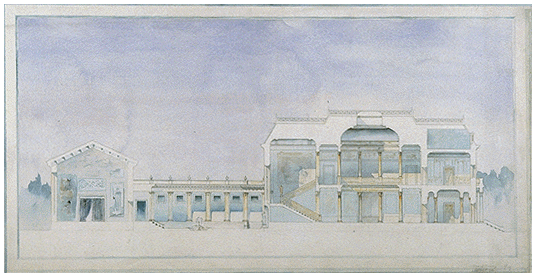
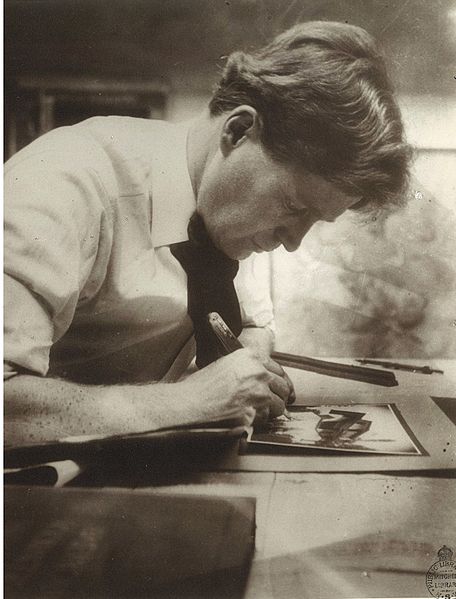
Walter Burley Griffin (November 24, 1876 – February 11, 1937) was an American architect and landscape architect, who is best known for his role in designing Canberra, Australia's capital city. He has also been credited with the development of the L-shaped floor plan, the carport and an innovative use of reinforced concrete.
Influenced by the Chicago based Prairie School, Griffin went on to develop a unique modern style. For much of his career Griffin worked in partnership with his wife Marion Mahony Griffin.
In the 28 years of their architectural partnership, the Griffins
designed over 350 buildings, landscape and urban design projects as well
as designing construction materials, interiors, furniture and other
household items.
Griffin was born in 1876 in Maywood, Illinois, a suburb of Chicago. He was the eldest of the four children of George Walter Griffin, an insurance agent, and Estelle Griffin. His family moved to Oak Park and later to Elmhurst during his childhood. As a boy he had an interest in landscape design and gardening, and his parents allowed him to landscape the yard at their new home in Elmhurst. Griffin completed high school at Oak Park High School. He considered studying landscape design but was advised by the landscape gardener O.C. Simonds to pursue a more lucrative profession.
Griffin chose to study professional architecture, and in 1899 he completed his bachelor's degree in architecture at the University of Illinois. The University of Illinois program was run by Nathan Clifford Ricker,
a German educated architect, whose teaching emphasized the technical
aspects of architecture. During his studies, Griffin also took courses
in horticulture and in forestry.
Following the completion of his studies Griffin relocated to Chicago and was employed as a draftsman for two years in the offices of progressive architects Dwight H. Perkins, Robert C. Spencer, Jr., and H. Webster Tomlinson in "Steinway Hall". Griffin's employers worked in the distinctive Prairie School style. The school's style is marked by horizontal lines, flat roofs with broad overhanging eaves, solid construction, craftsmanship, and strict discipline in the use of ornament. Louis Sullivan was highly influential amongst Prairie School and Griffin was a great admirer of his work, and also of his philosophy of architecture which stressed that design should be free of historical precedent. In addition to Sullivan, influential identified with the Prairie School architects include , George Grant Elmslie, George Washington Maher, William Gray Purcell, William Drummond and most importantly, Frank Lloyd Wright.
In July 1901, Griffin passed the new Illinois architects' licensing examination, and this permitted him to enter private practice as an architect. He began to work in Frank Lloyd Wright's famous Oak Park, Illinois, studios. Although he was never made a partner, Griffin oversaw the construction on many of Wright's noted houses including the Willits House in 1902 and the Larkin Administration Building built in 1904. From 1905 he also began to supply landscape plans for Wright’s buildings. Wright allowed Griffin and his other staff to undertake small commissions of their own. The William Emery house, built in Elmhurst, Illinois, in 1903 was such a commission. While working for Wright, Griffin fell in love with Mr. Wright's sister, Maginel Wright. He proposed marriage to her, but his affections for her were not returned, and she refused
Early in 1906 Griffin resigned his position at Wright's studio and established his own practice at Steinway Hall. Griffin and Wright had fallen out over events following Mr. Wright's trip to Japan in 1905. While Wright was away for five months, Griffin ran the practice. When Wright returned, he told Griffin that he had overstepped his responsibilities -- since Griffin had completed several of Writght's jobs, and he sometimes substituted his own building designs. Fruthermore, Mr. Wright had borrowed money from Griffin to pay for his travels abroad, and then he tried to pay off his debts to Griffin with prints he had gotten in Japan. It became clear to Griffin then that Wright would not make Griffin a partner in his business.
Griffin's first independent commission was a landscape design for the State Normal School at Charleston, Illinois, now known as the Eastern Illinois University. In the autumn of that year, 1906, he received his first residential job
from Harry Peters. The Peters' House was the first house designed with
an L-shaped or open floor plan. The L-shape was an economical design and
rather easily constructed. From 1907, 13 houses in this style were
built in the Chicago neighborhood now known as Beverly - Morgan Park.
Seven of these houses are on W. 104th Place in Beverly, Chicago.
This street is now known as Walter Burley Griffin Place, and it forms a
municipal historical district within the national Ridge Historic
District, as this block contains the largest collection of small scale
Griffin designs in existence.
In 1911 Griffin married Marion Lucy Mahony, a graduate of the Massachusetts Institute of Technology in architecture. She had been employed first in Wright's office, and then by the architect Hermann V. von Holst, who had taken over Wright's work in America when Wright abruptly left for Europe in 1909 -- eloping with a woman. Marion Mahony recommended to von Holst that he hire Griffin to develop a landscape plan for the area surrounding the three houses on Milliken Place for which Wright had been hired in Decatur, Illinois. Mahony and Griffin worked closely on the Decatur project immediately preceding their marriage. After their marriage, Mahony went to work in Griffin's practice. A Walter Burley Griffin and Marion Mahony designed development with several homes, Rock Crest Rock Glen in Mason City, Iowa, is seen as their most dramatic American design development of the decade and remains the largest collection of Prairie Style homes surrounding a natural setting.
From 1899 to 1914, Griffin created more than 130 designs in his Chicago office for buildings, urban plans and landscapes; half of these were built in midwestern states of Illinois, Iowa, Michigan and Wisconsin. In 1981, the city of Chicago granted landmark status to the Prairie style bungalows designed between 1909 and 1914 by Griffin in the 1700 block of West 104th Place (also known as the Griffin Place Historic District), as well as 12 blocks on Longwood Drive and three blocks along Seeley Avenue between 98th and 110th Streets.
The
relationship between Walter Burley Griffin and Frank Lloyd Wright
cooled in the years following Griffin's departure from Wright's firm in
1906. With Walter and Marion's wedding, Wright started to feel they were
"against him". After Griffin's win in the Canberra design competition,
and resultant front page coverage in the New York Times,
Wright and Griffin never spoke to each other again. In later years,
whenever Griffin was brought up in conversation Wright would downplay
his achievements and refer to him as a draftsman.
In April 1911, the Australian Government held an international competition to produce a design for its new capital city. Griffin produced a design with impressive renderings of the plan produced by his wife. They had only heard about the competition in July, while on honeymoon, and worked feverishly to prepare the plans. On May 23, 1912 Griffin's design was selected as the winner from among 137 entries. The win created significant press coverage at the time and brought him professional and public recognition. Of his plan, he famously remarked:
"I have planned a city that is not like any other in the world. I have planned it not in a way that I expected any government authorities in the world would accept. I have planned an ideal city - a city that meets my ideal of the city of the future."
In 1913, he was invited to Australia to inspect the site. He initially left Marion in charge of the practice and traveled to Australia in July. (His Chicago practice was soon taken over by Barry Byrne.) His letters home reveal his appreciation for the Australian landscape. While in Australia, Griffin was offered the position of head of the department of architecture at the University of Illinois. At the same time he was negotiating a three year contract with the Australian Government to remain in Australia and oversee the implementation of his plan, which to his dismay he felt had already been compromised. He was appointed the Federal Capital Director of Design and Construction. In this role, Griffin oversaw the design of North and South Canberra, though he struggled with political and bureaucratic obstacles. With the outbreak of World War I in 1914, Griffin was under pressure to reduce the scope and scale of his plans due to the Government diverting funds towards the war effort. Several parts of his basic design underwent change. For instance, plans to create Westbourne, Southbourne and Eastbourne Avenues to complement Canberra's Northbourne Avenue came to nothing, as did a proposed railway that would have gone from South Canberra to North Canberra, and then in a northwesterly direction to Yass. A market area that would have been at Russell Hill in North Canberra was moved southwards to what is now Fyshwick, next to South Canberra.
The pace of building was slower than expected, partly because of a lack of funds and partly because of a dispute between Griffin and Federal government bureaucrats. During this time, many of Griffin's design ideas were attacked by both the architectural profession and the press. In 1917, a Royal Commission determined that they had undermined Griffin's authority by supplying him with false data which he had used to carry out his work. Ultimately, Griffin resigned from the Canberra design project in December 1920 when he discovered that several of these bureaucrats had been appointed to an agency that would oversee Canberra's construction. The Commonwealth Government under the leadership of Prime Minister Hughes had removed Griffin as director of construction at Canberra after disagreements over his supervisory role, and in 1921 created the Federal Capital Advisory Committee, with John Sulman as chair. Griffin was offered membership, but declined and withdrew from further activity in Canberra.
Griffin designed several buildings for Canberra, none of which were ever built. The grave of General Bridges on Mount Pleasant was the only permanent structure designed by Griffin to be built in Canberra.
The Griffins' office in Chicago had closed in 1917; however, they had successful practices in Melbourne and Sydney, which were a strong motivation for their continuing to live in Australia. The Griffins had received commissions for work outside Canberra since Walter first arrived in the country in 1913, designing town plans, subdivisions, and one of his highly regarded buildings, Newman College, the Catholic residential college of the University of Melbourne while employed in Canberra. While supervising activities in Canberra, Griffin spent much time in Melbourne and, in 1918, became a founder, with Royden Powell, of the Henry George Club, an organization devoted to providing a home for the Single Tax movement. The Griffins' first major commission after leaving Canberra was the Capitol Theatre in Melbourne; it opened on November 7, 1924. In 1964 architectural writer Robin Boyd described the Capitol as "the best cinema that was ever built or is ever likely to be built".
In
1916 and 1917 Griffin developed a patented modular concrete
construction system known as “Knitlock” for use in the construction of
Canberra. No Knitlock buildings were ever built in Canberra, although
several were built in Australia. The first were built on Griffin's
property in Frankston in 1922, where he constructed two holiday houses called "Gumnuts". The best examples of Knitlock include the S.R. Salter House in Toorak and the Paling House. Frank Lloyd Wright designed a similar system and used Griffin's design to support the arguments for his design.
In 1919 the Griffins founded the Greater Sydney Development Association (GSDA), and in 1921 purchased 259 ha of land in North Sydney. The GSDA's goal was the development of an idyllic community with a consistent architectural feel and bushland setting. Walter Burley Griffin as managing director of the GSDA designed all the buildings built in the area until 1935. Castlecrag was the first suburb to be developed by the GSDA. The Redding House and several others in Castelcrag were also built in Knitlock. Almost all the houses Griffin designed in Castlecrag were small and had flat roofs, and he included an internal courtyard in many of them. Griffin used what was at that time the novel concept of including native bushland in these designs.
Other work the Griffins did during this time included the Melbourne subdivisions of Glenard and Mont Eagle at Eaglemont. Prior to 1920 the Griffins also designed the New South Wales towns of Leeton and Griffith.
The Griffins participated in the celebrated Chicago Tribune Tower Competition in 1922. Having won one famous international competition, as architects who were both well acquainted with Chicago and recognized as practical visionaries, they offered a solution that was positive, forward looking and elegant. Indeed their entry appears to be about a decade ahead of its time, with emphatic verticality along the lines of the Art Deco or Art Moderne. It anticipated and would have been a near neighbor of Chicago's 333 North Michigan by Holabird & Roche (1928); with stylistic echos in John and Donald Parkinson's Bullocks Wilshire, in Los Angeles (1929), as well as Adah Robinson and Bruce Goff's Boston Avenue Methodist Church, Tulsa (1929).
In
the 1920s they prepared plans for the Milleara Estate (also known as
City View) at Avondale Heights, and the Ranelagh Estate at Mount Eliza,
in conjunction with surveyors Tuxen and Miller. During the financial
hardship of the Depression in the 1930s Griffin was commissioned to
design incinerators; Willoughby Incinerator in the Sydney suburb of Willoughby is a good example of this work. Another example was built in the suburb of Pyrmont, not far from the center of Sydney.
During their time at the GSDA, the Griffins became more involved in anthroposophy, and in 1935 through contacts in the movement Griffin won a commission to design the library at the University of Lucknow in Lucknow, India.
Although he had planned to only stay to complete the drawings for the library, he soon received more than 40 commissions, including University of Lucknow Student Union building; a museum and library for the Raja of Mahmudabad; a zenana (women’s quarters) for the Raja of Jahangirabad; Pioneer Press building, a bank, municipal offices, many private houses, and a memorial to King George V. He also won complete design responsibility for the 1936 – 1937 United Provinces Exhibition of Industry and Agriculture. His 53 projects for the 160 acre (0.65 km2) site featured a stadium, arena, mosque, imambara, art gallery, restaurant, bazaar, pavilions, rotundas, arcades, and towers, however, only part of his elaborate plans were fully executed. Griffin was inspired by the architecture and culture of India, modifying forms as "he sought to create a modern Indian architecture... Griffin was able to expand his aesthetic vocabulary to create an exuberant, expressive architecture reflecting both the 'stamp of the place' and the 'spirit of the times'". While in India, Griffin also published numerous articles for the Pioneer, writing about architecture, in particular about ventilation design improvements. His wife Marion traveled to Lucknow in April 1936 to assist and contributed to several projects.
Griffin died of peritonitis in early 1937, five days after gall bladder surgery at King George's Hospital in Lucknow, and was buried in Christian Cemetery in Lucknow. Marion Mahony Griffin oversaw the completion of the Pioneer Building that he had been working on at the time of his death. She closed down their Indian offices, then left their Australian practice in the hands of Griffin's partner, Eric Milton Nicholls, and then returned to Chicago.
Griffin was largely under - appreciated during his time in Australia, but since his death there has been a growing recognition of his work. In 1964 when Canberra finally got its central lake (as Griffin had intended), Prime Minister Robert Menzies declined to have the lake named after himself, and he instead named it Lake Burley Griffin, and this became the first monument in Canberra dedicated to the city's designer ("Burley" was included in the name because of the misconception that it was part of the Griffins' surname). Architectural drawings and other archival materials by and about the Griffins are held by numerous institutions in the United States, including the Drawings and Archives Department of Avery Architectural and Fine Arts Library at Columbia University; the Block Gallery at Northwestern University; the Ryerson & Burnham Libraries at the Art Institute of Chicago; and the New York Historical Society, as well as in several repositories in Australia, including the National Library of Australia, National Archives of Australia, and the Newman College Archives of the University of Melbourne.
...."I
am what may be termed a naturalist in architecture. I do not believe in
any school of architecture. I believe in architecture that is the
logical outgrowth of the environment in which the building in mind is to
be located".... From The New York Times, Sunday, June 2, 1912
